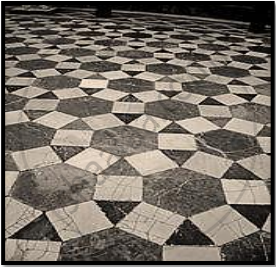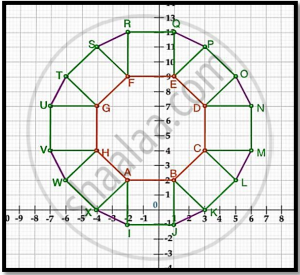Advertisements
Advertisements
Question
Points P, Q, R and S divides the line segment joining A(1, 2) and B(6, 7) in 5 equal parts. Find the coordinates of the points P, Q and R.
Solution

It is given that P, Q, R and S divides the line segment joining A(1, 2) and B(6, 7) in 5 equal parts.
∴ AP = PQ = QR = RS = SB .....(1)
Now,
AP + PQ + QR + RS + SB = AB
⇒ AP + AP + AP + AP + AP = AB [From (1)]
⇒ 5AP = AB
⇒ AP = \[\frac{1}{5}\] AB .....(2)
Now,
PB = PQ + QR + RS + SB = \[\frac{1}{5}\] AB + \[\frac{1}{5}\] AB + \[\frac{1}{5}\] AB + \[\frac{1}{5}\] AB = \[\frac{4}{5}\] AB .....(3)
From (2) and (3), we get
AP : PB = \[\frac{1}{5}\] AB : \[\frac{4}{5}\] AB = 1 : 4
Similarly,
AQ : QB = 2 : 3 and AR : RB = 3 : 2
Using section formula, we get
Coordinates of P = \[\left( \frac{1 \times 6 + 4 \times 1}{1 + 4}, \frac{1 \times 7 + 4 \times 2}{1 + 4} \right) = \left( \frac{10}{5}, \frac{15}{5} \right) = \left( 2, 3 \right)\]
Coordinates of Q = \[\left( \frac{2 \times 6 + 3 \times 1}{2 + 3}, \frac{2 \times 7 + 3 \times 2}{2 + 3} \right) = \left( \frac{15}{5}, \frac{20}{5} \right) = \left( 3, 4 \right)\]
Coordinates of R = \[\left( \frac{3 \times 6 + 2 \times 1}{3 + 2}, \frac{3 \times 7 + 2 \times 2}{3 + 2} \right) = \left( \frac{20}{5}, \frac{25}{5} \right) = \left( 4, 5 \right)\]
APPEARS IN
RELATED QUESTIONS
Name the quadrilateral formed, if any, by the following points, and given reasons for your answers:
A(-1,-2) B(1, 0), C (-1, 2), D(-3, 0)
The line segment joining the points P(3, 3) and Q(6, -6) is trisected at the points A and B such that Ais nearer to P. If A also lies on the line given by 2x + y + k = 0, find the value of k.
If the poin A(0,2) is equidistant form the points B (3, p) and C (p ,5) find the value of p. Also, find the length of AB.
Points A(-1, y) and B(5,7) lie on the circle with centre O(2, -3y).Find the value of y.
Prove that the diagonals of a rectangle ABCD with vertices A(2,-1), B(5,-1) C(5,6) and D(2,6) are equal and bisect each other
Find the possible pairs of coordinates of the fourth vertex D of the parallelogram, if three of its vertices are A(5, 6), B(1, –2) and C(3, –2).
Show that the points (−4, −1), (−2, −4) (4, 0) and (2, 3) are the vertices points of a rectangle.
If (0, −3) and (0, 3) are the two vertices of an equilateral triangle, find the coordinates of its third vertex.
If the point \[C \left( - 1, 2 \right)\] divides internally the line segment joining the points A (2, 5) and B( x, y ) in the ratio 3 : 4 , find the value of x2 + y2 .
Write the perimeter of the triangle formed by the points O (0, 0), A (a, 0) and B (0, b).
Write the ratio in which the line segment joining points (2, 3) and (3, −2) is divided by X axis.
The ratio in which (4, 5) divides the join of (2, 3) and (7, 8) is
f the coordinates of one end of a diameter of a circle are (2, 3) and the coordinates of its centre are (−2, 5), then the coordinates of the other end of the diameter are
The point on the x-axis which is equidistant from points (−1, 0) and (5, 0) is
If P(2, 4), Q(0, 3), R(3, 6) and S(5, y) are the vertices of a parallelogram PQRS, then the value of y is

In the above figure, seg PA, seg QB and RC are perpendicular to seg AC. From the information given in the figure, prove that: `1/x + 1/y = 1/z`
Ordinate of all points on the x-axis is ______.
Find the coordinates of the point whose ordinate is – 4 and which lies on y-axis.
A tiling or tessellation of a flat surface is the covering of a plane using one or more geometric shapes, called tiles, with no overlaps and no gaps. Historically, tessellations were used in ancient Rome and in Islamic art. You may find tessellation patterns on floors, walls, paintings etc. Shown below is a tiled floor in the archaeological Museum of Seville, made using squares, triangles and hexagons.

A craftsman thought of making a floor pattern after being inspired by the above design. To ensure accuracy in his work, he made the pattern on the Cartesian plane. He used regular octagons, squares and triangles for his floor tessellation pattern

Use the above figure to answer the questions that follow:
- What is the length of the line segment joining points B and F?
- The centre ‘Z’ of the figure will be the point of intersection of the diagonals of quadrilateral WXOP. Then what are the coordinates of Z?
- What are the coordinates of the point on y-axis equidistant from A and G?
OR
What is the area of Trapezium AFGH?
